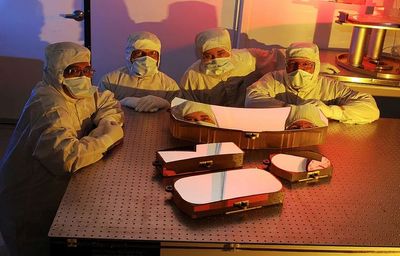
Special Topics: LDCM and LDCM Components
The OLI telescope uses a four-mirror compact design. The optics are positioned inside a lightweight, yet highly stable, carbon composite optical bench (i.e., a substrate on which the optics are mounted) that has special features to control undesired stray light (stray light is any light entering the optics from someplace other than the observed Earth surface, or imaging "target").
Because OLI is a push-broom instrument, as opposed to a scanner (or "whisk-broom"), it has a wide field-of-view to cover the entire ground swath width. Wide field-of-view telescopes are generally susceptible to stray light, so the OLI telescope is designed for improved stray light control. The number and shapes of the mirrors meet the required optical design parameters, like focal length, for example, within a size that also meets the volume and mass requirements for the instrument.
Note: The previous Landsat sensors have used scanner or "whisk-broom" technology. This means that a mirror scans from side-to-side across the satellite path directing light into the instrument detectors. The OLI uses push-broom technology meaning that an array of detectors is used to image the entire swath/width of the satellite path simultaneously.






